
LC.
A magazine dedicated to Le Corbusier
Bi-annual publication of the University Politècnica de València in partnership with the Fondation Le Corbusier
The first issue of L’Esprit Nouveau came out in October 1920. The magazine, actually managed by Amedée Ozenfant and Le Corbusier, proposed to its readers “to explain the spirit that animates the contemporary era; to express the beauty of this time, the originality of its spirit (…) to show the unitary spirit that encourages the different elites of our Society in their investigations. To present and to clearly comment on the works, research, ideas of those who lead our civilization nowadays”.
LC, in a similar way, wishes to become a new journal whose epicentre will be Le Corbusier and the plurality of his work. Initially, the book L’atelier de la recherche patiente was to receive the title of Le Corbusier et son temps, as Le Corbusier himself wanted to be a man of his time. Like L’Esprit Nouveau, LC wants to be a “global journal dedicated to the aesthetics of our time, in all its manifestations”. This is our program: to describe generous convolutions starting from the figure of Le Corbusier in order to apprehend the aesthetics and arts of our time. We also want to recognize a heritage that will be oriented towards the future, in order to allow us to gather a wide spectrum of articles that can investigate the origins of Charles Edouard Jeanneret, his predecessors, his time, until his emergence, manifestation and decline, in the present and in the future. Trying to achieve this goal through any artistic manifestation without any limit or a priori.
The journal will publish articles including biographical, literary or textual researches, as well as analysis of architectural projects, plastic creations, designs or music, essays on genetic or inferential criticism, graphic or photography works, essays on aesthetics, etc. Our only requirement will be to promote a recherche patiente in which Le Corbusier will always be a part, even in the background. Almost a hundred years ago Le Corbusier praised the “spirit of construction and synthesis, guided by a clear conception”, therefore, we will strive to give priority to rigorous, original and meaningful research.
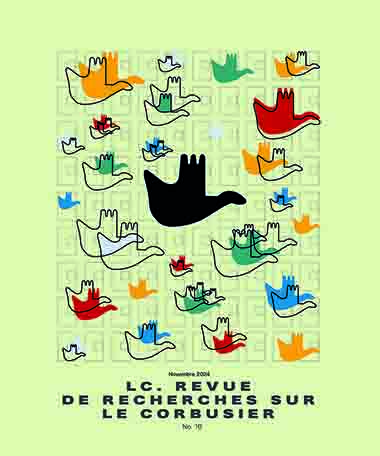
LC. No. 10 — November 2024
José Oubrerie, in memoriam
Unfortunately, after the tragic death of Jean-Louis Cohen, this Editorial has to begin again with an expression of condolences, which in this case is threefold. First of all, we dedicate this issue to the figure of José Oubrerie, the last surviving member of Le Corbusier’s direct collaborators, who left us on10 March 2024. After joining the rue de Sèvres atelier in 1959, Oubrerie played a key role in the last six years of the studio’s activity, until the master’s death in 1965, participating in some of the most important projects of this last stage. He then went on to develop a long personal architectural and teaching career. Luis Burriel, who devoted his doctoral thesis to the Saint-Pierre de Firminy-Vert project, gives an account of all this in the section Le Corbusier contemporain, in a long interview with the architect in 2014. The text of the interview is accompanied by a large representation of the plans drawn up by José Oubrerie for some of Le Corbusier’s projects.
Read more
On 2 August 2024 we also suffered the painful loss, after a painful illness, of Ana del Cid, professor at the School of Architecture of Granada and member of the Editorial Committee of our magazine, towhich she always generously lent her collaboration.
And finally, we would like to express our sympathy for the victims of the catastrophic floods which, at thetime of writing, have just struck the Spanish Levante region: a tragedy which we feel very close to usbecause it is in Valencia, one of the worst affected areas, where this magazine is published and where one of its directors teaches at the School of Architecture.
José Miguel Gómez Acosta and Daniel López Martínez are the authors of the cover of this issue, a rich plastic and chromatic play on the motif of the open hand. This is the third cover that the authors have designed for LC with a generosity for which we thank them.
The guest article in this case is by Tim Benton, who provides us with a wide-ranging and novel investigation into the figure, always somewhat blurred, of Jean Badovici. Based on a detailed study ofthe houses that Badovici renovated in Vézelay, he provides a better understanding of the Romanianarchitect’s modus operandi and offers food for thought on the great theme of the relationship betweenthe modern and the vernacular. At the same time, it brings us closer to the figure of Eileen Gray in the moments before the famous episode of the E-1027 house in Cap-Martin.
Of the four investigations that make up the Recherches section, two are framed within the question ofEurope-America relations: Moisés Chávez studies the relations between Carlos Raúl Villanueva and Le Corbusier, and Carlos Ferrera analyses the trajectory of José Luis Sert and Antonio Bonet Castellana,both disciples and collaborators of Le Corbusier, between the Spanish GATEPAC and his exile. Also inthis section is an investigation by Clervie Beaucousin into the role of glass in Le Corbusier’s work, takingthe Tokyo Museum as a case study and at the same time exploring its relationship with Japan. Finally, Pedro Ponce, Ignacio Peris and Salvador Sanchís offer new reflections on the frustrated project for the Palace of the Soviets, based on the study of its presence in publications published well after the proposal and, therefore, in a different context of debate.
The Documentation section includes an interesting unpublished document: the interview conducted inJune 1936 with Le Corbusier by the journalist and editor Edna Nicoll, which dealt mainly with the architect’s vicissitudes in relation to the 1937 World’s Fair. In it, Le Corbusier summarises his various projects and his subsequent disappointments in this regard from 1932 onwards and provides additional information on a process that would culminate in the Pavillon des Temps Nouveaux.
This issue closes with three bibliographical reviews. Iñaki Bergera comments on the recent book by Veronique Boone on the films shot by the Croatian architect Ernest Weissmann during his stay at the rue de Sèvres studio. The other two deal with two recent books on Le Corbusier and India: Miguel Ángel de la Cova analyses Sarbjit Bahga and Arun Mirchandani’s Making of Chandigarh: A vintagehistory and Vikramaditya Prakash looks at Maristella Casciato’s edition of the 1951 Album of the Punjab.
As in previous issues, we are pleased to note the growing consolidation of the journal in academic and architectural circles and express our sincere thanks to all the people and institutions that make it possible, especially the Fondation Le Corbusier and the Editorial Universitat Politècnica de València.
Juan Calatrava / Arnaud Dercelles / Jorge Torres
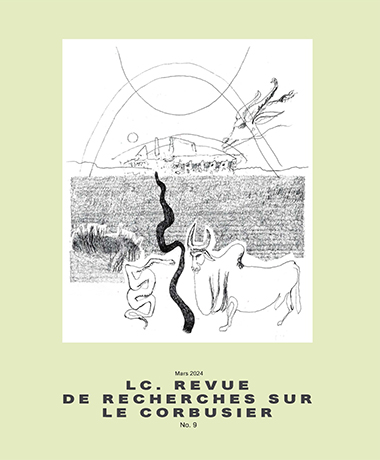
LC. No. 9 — March 2024
Le Corbusier — Une recherche patiente
LC issue number 9 presents a heterogeneous set of contents, featuring a diversity of fields for reflection and innovative results that demonstrate, once more, how the line of research on Le Corbusier is still far from exhausting its capacity for development, regardless of what the immense growing number of published works may suggest.
In this issue, we continue our homage to the late Jean-Louis Cohen. The section ‘Article invité’ presents the second part of his introduction to the English edition of Vers une architecture. It features, in the same way as the first part published in our previous issue, the original text in French supported by abundant visual material.
Read more
Jean-Louis Cohen is equally starring in the section “Le Corbusier Contemporain.” In it, the text authored by Arnaud Dercelles and Rémi Baudoui introduces less-known aspects of Cohen’s life and his professional trajectory, not limiting their focus to biographical aspects but, overall, allowing to frame his figure in the continuity of a very special familiar trajectory and a highly complex political and cultural context. Leaving aside any hagiographic temptation, this article allows for a better critical and historiographical understanding of a researcher and friend who had a profound impact on the universe of studies on Le Corbusier.
The section “Recherches” comprises five articles about quite different topics. Gabriele Gardini studies Le Corbusier’s 1922 trip to Veneto and analyzes its impacts on his architectural work and thinking, which may have been produced by his direct knowledge of Andrea Palladio’s main villas. Leda Dimitriadi tackles the topic of geometry and, far from the usual reflections of philosophic or even hermetic nature, she descends into the study of the role of geometry in Le Corbusier’s practice of design and construction, based on two very significant study cases: Chandigarh’s Palace of Assembly and the Chapel of Ronchamp. Monica Luce Bohrer combines two important questions in his text: the relationship of Le Corbusier with England and the discussion on exposition pavilions. Her article highlights the figure of Clive Entwistle, expanding the circle of relevant characters among Le Corbusier’s acquaintances and, at the same time, based on his English exposition projects, analyzing the deliberate use of exhibitions among the communication strategies of Le Corbusier. Sayuri Hayakawa and Taji Takahiro present a new contribution to the discussion on Le Corbusier’s political ideas. Through an unprecedented approach to young Jeanneret’s early manuscript, La Construction des Villes, they show how it does not unfold an aseptic study on urban planning but a whole political landscape marked by the contemporary French patriotic debate and, more specifically, by Georges de Montenach ideas. Lastly, Stephen Atkinson’s contribution unveils the existence, at the core of the architect’s work, of a kind of private language, filled in equal parts by symbolism, esoterism, and private humor, featuring images of faces, phallic elements, and a continuity of recurring images such as bulls. The author, who links this imagery with Le Corbusier’s interest in Rabelais, situates himself in line with the most recent studies on the symbolic aspects of his cosmovision.
In the section “Documentation,” Iñaki Bergera presents a report on Pessac, composed of twenty-seven photographic pictures taken by himself and an introductory text connecting his contemporary vision with the analysis of how time has passed over the true palimpsest that are the Quartiers Frugès.
Lastly, in “Recensions” three important recent contributions on Le Corbusier have been reviewed. Clara E. Mejía Vallejo comments on the volume Five brief reflections on Le Corbusier’s work, edited by Alejandro Lapunzina, whose text accompanies others by Juan Calatrava, Pere Fuertes, Josefina González Cubero y Jorge Torres Cueco, introduced by Brigitte Bouvier and another text by Rene Tan featuring her model exhibition LC 150+. Pablo Marti Ciriquián highlights the main aspects of Juan Andrés Rodríguez Lora’s PhD dissertation El otro urbanismo de Le Corbusier. Una mirada atenta a su legado urbanístico. Jorge Torres analyzes Tim Benton’s The Painter Le Corbusier: Eileen Gray’s Villa E 1027 and Le Cabanon.
Once more, we are pleased to see how our journal advances in its consolidation among the lecorbusierian panorama. The growing number of visits and downloads, as well as the quantity of article proposals submitted, allow us to approach the journal’s future with serenity. We express our most sincere appreciation to the readers, authors, and members of our different committees, as well as to Fondation Le Corbusier for its continuous support.
Juan Calatrava / Arnaud Dercelles / Jorge Torres
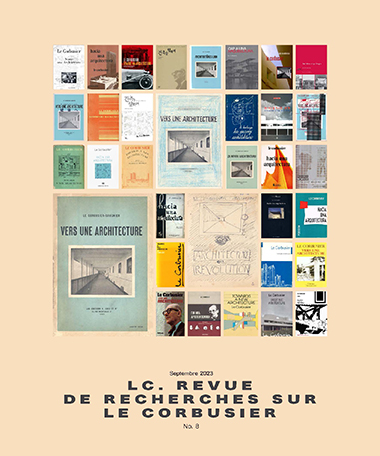
LC. No. 8 — September 2023
Jean-Louis Cohen — Vers une architecture
Just when we were about to close this September issue, delighted with how it opens with one of his articles, we heard the news of Jean-Louis Cohen premature, untimely passing. Architect, architectural historian, professor, and member of the scientific committee of revue LC, while also a key figure of the Corbuserian community and, overall, a friend who shared his advice with us for many years.
We cannot yet fully measure the extent of our loss, but we know well how Cohen contributed to architectural knowledge and its communication. We could easily get lost in flattery and talk about the multilingual, erudite, hypermnesic. We could evoke his dominion over the method and his sense of humour, as well as we could go astray across numerous lists: those of his writings, his exhibitions, his lectures, his courses, etcetera. From New York’s Institute of Fine Arts to the Collège of France, Jean-Louis was and is an inspiration for all. His writings perdure, as well as his memory, but our grieve is great.
Read more
This issue, conceived as a celebration of Vers une architecture first centennial, opens with a reedition of the text that Jean-Louis Cohen had in store for the introduction of the American edition of this book. Its first part is published in this issue, while the second will be published in March. In continuity with this homage, the issue also features a fragment of Elisabeth Essaïan’s unpublished interview with Jean-Louis Cohen, where he talks about his research on architecture.
Following the trail of this book, Françoise Ducros presents the second part of his article on L’Art Décoratif d’aujourd’hui,the ‘left wing’ of Vers une architecture, introducing the question about the relationship between functional design and modernity in the framework of a new social reality. Sjoerd van Faassen and Herman van Bergeijk present an extensive essay confronting the architectural ideas of van Doesburg and Le Corbusier at the time of the publication of Vers une architecture and the creation of Maison d’Artiste. José Miguel Mantilla travels back to a specific formative period for young Jeanneret, spending some months in Viena between 1907 and 1908, and transforming his vision of German romanticism through the figures of Gottfried Semper and Richard Wagner. Covadonga Blasco introduces a new reading of Ronchamp’s roofs in which she identifies the organs of a whale and unveils how its hidden underside is also a work of art. Christine Kelley examines the ‘chiasm’ rhetoric figure, the axial concept in the essay ‘Architecture, pure création de l’esprit’ featured in Vers une architecture, studying how is it implemented in Le Corbusier’s architecture.
Fondation Le Corbusier archival holdings related to Vers une architecture are the subject of this issue’s ‘Documentation’ section. A selection of drawings, texts, and documents show the universe surrounding the creation of the book in its diverse editions. From Le Corbusier’s 1922 correspondence with Éditions Crès, the introduction to the book’s second edition, a selection of illustrations featured in small drafts, to the 1958 edition jacket and a papier collé allusive to the figure of a bull; this kaleidoscope of images and ideas shape a book still relevant today.
LC Contemporain presents responses to a short survey on Vers une architecture, kindly answered by Iñaki Ábalos, Tadao Ando, Tim Benton, Antón Capitel, Carlos Eduardo Comas, William J. R. Curtis, Luis Fernández Galiano, Roberto Gargiani, Toyo Ito, Ryue Nishizawa, Antoin Picon, Carlo Olmo, José Oubrerie, Víctor Pérez Escolano, José Manuel del Pozo, Josep Quetglas, and Arthur Rüegg. Their replies come accompanied with the covers of Vers une architecturedifferent editions.
Finally, this issue features two new book reviews. The first one focuses on the second volume of Le Corbusier’s drawings catalogue raisonné. The second review addresses the relationship between Le Corbusier and Joseph Savina, presenting an integral study on the latter’s trajectory.
Once more, we close this editorial by thanking our readers for the excellent reception of revue LC and acknowledging the fidelity of researchers who continue to submit their manuscripts. We equally express our appreciation to all our collaborators, reviewers, and, of course, authors, as well as to the editorial and scientific committees. Our last piece of thought in this editorial is for Jean-Louis Cohen.
Juan Calatrava / Arnaud Dercelles / Jorge Torres
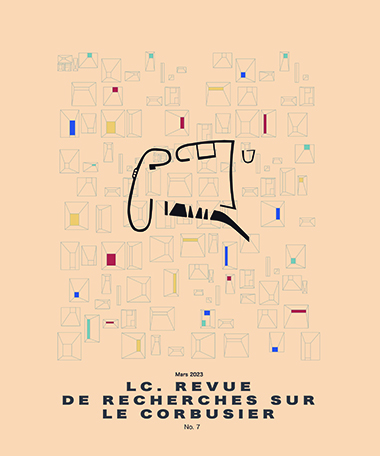
LC. No. 7 — March 2023
Le Corbusier's varia
The reductionist vision that considered Le Corbusier simply as the leader of modern functionalism is facing an historiographical turn in the last decades. It allows us to understand all the immense wealth of thought and creative activity of the master. This new issue of LC presents a clear representation of the variety and wide range of topics, types and problems that have always been building the vision of a creator. An architect determined to face all the challenges and questions that his own time posed to him.
The invited article, by Rémi Baudouï and Arnaud Dercelles, addresses a relevant topic in the context of recent debates on Le Corbusier and his political approach: his cosmopolitanism. Leaving aside controversies that are more mediatic than scientific, authors analyse the evolution of Le Corbusier’s deep cosmopolitan feeling. It is not just about his strong international presence, but about a deep humanist feeling, philosophically anchored in the ideas of peace and progress, which explains the motivations of some of his projects.
Read more
The research section in this issue consists of five contributions that can be seen together as a sample of the kaleidoscopic variety of Le Corbusier’s activity. The first, by Gabriele Gardini, studies Le Corbusier’s first trip to Venice (in 1907). Still influenced by John Ruskin, he would discover medieval architecture in Venice, as well as a world of colours and sensations. They would remain forever in his memory and in his way of integrating the lessons of the past into the present. Julie Cattant addresses a transversal theme of great interest: Le Corbusier’s obsession with the horizon line. Her study of the importance of that topic for the architect reveals how dense poetic reflections, along with landscape or purely architectural motivations, are inserted in his complex worldview. The third article, written by Alejandro Vírseda and Carlos Labarta, traces the history of the concept of the boîte à miracles from its theoretical origins, linked to the idea of the espace indicible, to its late attempts at its construction. Authors argue how in the progressive definition of the boîte à miracles Le Corbusier creates a distance with the idea of machine à habiter. Richard Klein studies one of least known Le Corbusier’s projects: the Strasbourg Congress Hall (1962-1965). It shows us how the very late Le Corbusier is completely receptive to the modern concepts of the spectacular and to the latest advances in light and sound equipment (as he already demonstrated in Brussels in 1958). The research section closes with the contribution of Françoise Ducros and the first part of her studies on L’Art Décoratif d’Aujourd’hui. She analyses the content of this important theoretical work and its imbrication in a broad context, related to the adventure of L’Esprit Nouveau, to the Exposition Internationale des Arts Décoratifs of 1925 and, especially, to Vers une architecture.
The “Documentation” section consists of a historical and iconographic report by Patrick Mosser on the villa “Le Lac”. A house designed by Le Corbusier for his parents that is close to be centenary. Ten photographs carefully chosen to illustrate the passage of decades and the lives of its inhabitants (including animals) through this building that the architect so intimately loved.
The section “Contemporary Le Corbusier” echoes the LC 150+ exhibition, created by the architecture studio RT+Q Architects, that includes more than 150 models of Le Corbusier’s projects. Alejandro Lapunzina talks with the architect Rene Tan about the meaning and scope of this exhibition on its presentation at the ETS Arquitectura del Vallés, thanks to the study program in Barcelona of the University of Illinois.
This seventh issue of the magazine is completed by three reviews of recently published books on the Ronchamp Chapel by Josep Quetglas, Rafael Moneo, and Claude Maisonnier. The joint reading of these three reviews shows the complementarity of these works and presents new keys to better understand Ronchamp.
Juan Calatrava / Arnaud Dercelles / Jorge Torres
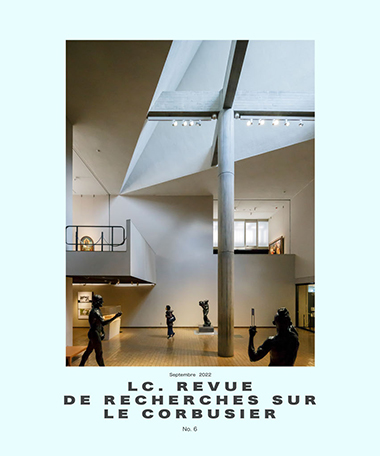
LC. No. 6 — Septembre 2022
The lesson of Le Corbusier
In the first issue of the journal Focus (1938), published by the students of the London Architectural Association, Le Corbusier wrote a short article entitled “ If I had to teach you architecture”, which was published in the Spanish version by Ediciones Infinito as an addendum to the Message to Architecture Students, entitled “If I had to teach you architecture”. Here he stated that he would begin by prohibiting “orders”, insisting on real respect for Architecture, on how moving the Acropolis or the Palazzo Farnese are, to emphasise the “fact that nobility, purity, intellectual perfection, plastic beauty and the eternal quality of proportion are the fundamental joys of architecture”. He proposed, then, a lesson in architecture. This question underlies this issue of LC. Revue de recherches sur Le Corbusier.
Read more
Arthur Rüegg invites us to reflect on the Zurich Pavilion, conceived as a model house for Heidi Weber, and a place of interaction for all the creative disciplines practised by its author. Following the restoration carried out by Silvio Schmed and Arthur Rüegg, the most important aspects of which are highlighted, the latter has curated three successive exhibitions: “Mon univers: Le Corbusier’s World of Objects”, “Le Corbusier and Zurich” and “Le Corbusier and Color”, which have been conceived according to the specific qualities of the different parts of the Pavilion. This is revealed as a manifesto of his idea of the “synthèse des arts majeurs”.
The research articles show different “lessons” from Le Corbusier. Oljer Cardenas deals with the residential work of Pierre Jeanneret, from his work in the atelier to his housing projects in Chandigarh, in which the teachings of his cousin were decisive. Pedro Feduchi and Pedro Reula focus on the relationship of Carlos Arniches and Martín Domínguez with Le Corbusier and his reception in Spain through the presence of the chaise longue in Edgar Neville’s flat, refurbished by them in 1927. Guillemette Morel’s proposal is based on the well-known photograph of those attending the constitution of the CIAM in La Sarraz in 1928, to propose a revision of the correspondence between Le Corbusier and Sigfried Giedion to reformulate a historiographical question: the reality of the myth of the “modern” “movement”. Finally, José Morales looks at some aspects of Le Corbusier’s creative process, in constant tension between multiple limitations and his desire for plastic freedom.
The “Documentation” section has a dual purpose. On the one hand, it presents Le Corbusier’s message to the congress “Il problema di Venezia” held in 1962 on intervention in a historic city like Venice. His response was intimately linked to his profound knowledge of the city, which he visited seven times. On this occasion, exhaustive documentation of material from the Fondation Le Corbusier, the Bibliothèque de La Chaux-de-Fonds and some private collections on his relationship with this city is offered. The drawings and photographs of 1907, the notes for the publication of the book La Construction des villes, the watercolours of 1922, his articles and the recognition of the urban structure reinterpreted in the project for the Venice Hospital, as well as his collection of postcards, constitute material that Jorge Torres has made available to future researchers. Nevertheless, it is a demonstration of what Venice was for Le Corbusier: an intense and poetic lesson in architecture.
“Le Corbusier Contemporain” is dedicated to the work of the architect and photographer Miguel Campuzano, accompanied by a suggestive essay by Miguel Ángel de la Cova, which reveals the conceptual complexity enclosed in the manipulation of his photographs taken with a simple polaroid machine. Memory, allegory of remembrance, estrangement, superimposition, etc… are questions that could explain the evocative character of these images.
Finally, two new book reviews on Le Corbusier are offered. The first is devoted to his architectural philosophy and the construction of a self-normative framework. The second one deals with the relationship between Le Corbusier and a singular client, Jan Antonín Bat’a.
We hope that readers will be nourished in this issue by the lessons Le Corbusier taught through drawings, projects, books, works of art and architecture. We are grateful for their loyalty to the journal, to the researchers who provide us with their work and to all the contributors who participate in this teaching work which Le Corbusier practised in many different formats and procedures throughout his life.
Juan Calatrava / Arnaud Dercelles / Jorge Torres
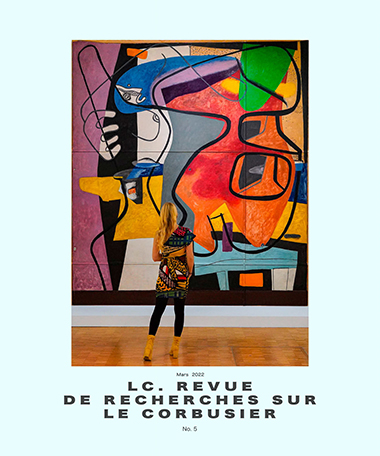
LC. No. 5 — Mars 2022
Unité
The notion of unity emerges as one of the most pressing slogans in Le Corbusier’s thought. This unity extended to all facets of human life and, very especially, to all the different artistic disciplines that had to merge into a single art, in which painters, designers, sculptors or architects were integrated. Yves Simon used to say that “artists are those who spend their lives putting together the separate pieces of the world” and Le Corbusier occupied a prominent place among them. In a certain way, this is the idea that presides over a good part of this no. 5 of the journal LC. Revue de recherches sur Le Corbusier.
The title of this editorial comes from that collection of etchings contained in the folder of the same name, that we published now in its entirety. It is an occasion to admire this tireless and patient work that Le Corbusier carried out between 1953 and 1965. In the introductory text, Juan Calatrava reveals the significance of this work and the relationships with other counterparts, especially Le Poème de l’angle droit.
Read more
In parallel, the work by the artists Mélanie Feuvrier and Hugo Fortin is presented in this issue. It was made during their residence in Le Corbusier’s apartment-atelier and exhibited at the Maison La Roche. The traces left by the daily movements that a door has left on the floor are captured on several sheets of paper. Traces are relocated on polychrome panels evoking the presence of Le Corbusier, in a game of multiple resonances between architecture and memory.
The cover of this issue, designed by @Matchwithart, is also a manifesto, as it offers us both a reflection on the reception of artistic work, and the involvement between disciplines such as fashion, photography, or painting. Probably, Le Corbusier would have contemplated this image with satisfaction, as it is ready to be transmitted by means of diffusion then unsuspected.
The “Research” section of the journal offers five new approaches to the work of Le Corbusier and his epigones. Guillermo Guerra enters the house that the architect Bustillo built for Victoria Ocampo in Buenos Aires, which is superimposed on another proposal made by Le Corbusier for the same person but in another place. His intention is to reveal the reality of this commission, its vicissitudes and the confusion that has arisen. Patrick Burniat dedicates his article to the concept of the open plan in Le Corbusier and, under the metaphor of the game so dear to Le Corbusier, he explains his compositional strategies in the 1920s and 1930s. Christoph Schnoor delves into the evolution of the initial urban conceptions of Le Corbusier, which is evident in his studies at the Bibliothèque Nationale and in the sketches made in a practically unpublished notebook during his stay in 1915 in Paris. Marta Sequeira, Juan-Andrés Rodríguez-Lora and María Teresa Pérez-Cano dedicate their article to the city and to Le Corbusier’s change in attitude, manifested in his selective and interested gaze in the conservation of the inherited city, with the city of Algiers as an example. Finally, Luis Burriel addresses with rigor and depth the presence of Le Corbusier in the work of OMA, as a persistent exploration of his strategies, recontextualized today.
Susanna Caccia Gherardini and Carlo Olmo conclude their generous essay on the restoration of the Villa Savoye, which in this second chapter covers the years 1980-87, with interventions by Yvan Gury and Jean-Louis Véret. At the same time, a disquisition is offered on the historiographical studies initiated with the opening of the Fondation Le Corbusier, raising the problem of the authority of those who act in a “supersigned” building such as the Villa Savoye.
Two recent books on Le Corbusier are offered in the reviews section. The first one is dedicated to the formative process of the young Jeanneret, his book La Construction des Villes, and its impact on his urban theories. The second book deals with the concept of open plan, decisive as a strategy to “put in tension” his architecture and his creative work.
This issue of the journal tries to respond to that search for unity -so necessary in the difficult times that humanity is living- that is manifested in all artistic activities, from urban planning to plastic creation, and whose fruits we observe in the most recent creations. We thank all those who collaborate in this work and, of course, our readers and institutions that participate in this task of bringing together “the separate pieces of the world”.
Juan Calatrava / Arnaud Dercelles / Jorge Torres
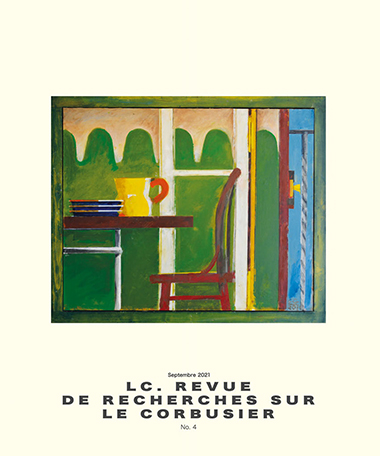
LC. No. 4 — Septembre 2021
Giuliano Gresleri, in memoriam
This fourth issue of LC is unfortunately marked by the death of Giuliano Gresleri, on December 20th. Architect, architectural historian, critic, theoretician and professor, Giuliano Gresleri has been an essential historical pillar of research on Le Corbusier, and we wished to pay tribute to his memory through a tribute issue.
Read more
A particular issue, a particular cover. This is a lively and colourful painting, realized by by Giuliano Gresleri in 2019, which could evoke a Le Corbusier interior. The section “Recherches” [Research] also had to reflect the imprint he left on our knowledge of Le Corbusier’s work. Two memorial articles occupy this section: José Oubrerie remembers his close friendship with Giuliano, materialized in, among other things, their collaboration for the reconstruction of the Pavillon de l’Esprit Nouveau in Bologna, while Danièle Pauly summarizes Gresleri’s relevance as an architecural historian. Moreover, we could not do less than present an original and unpublished article written by Giuliano Gresleri (in its original Italian version and in a Spanish translation), selected by his son Jacopo, who has generously accompanied the production of this issue.
This section is completed with two more articles and an interview. Aurora Alison deepens into Le Corbusier’s aesthetic thinking and the importance that a particular mode of sensory-based thinking has in his reflections. She proposes, in this line of thought, the hypothesis of a conceptual relationship between Le Corbusier and the great thinker of space that was Gaston Bachelard. Bartolomé Serra and Alfonso Díaz analyze two of the great urban projects from the mid-20s, the settlements of Lège and Pessac, as attempts to formalize the reflections contained in Vers une architecture. Their study presents new contributions to the general knowledge on Le Corbusier’s continuous travel between theory and project and between urbanism and housing. Finally, this section closes with the interview by Véronique Boom and Gregorio Carboni’s with Kenneth Frampton. It traces an ample prospect of Le Corbusier’s significance in the construction of Frampton’s historical vision of 20th century architecture. This interview also induces us to reconsider the role of interviews as a tool for producing knowledge of the highest value.
In the section “Article Invité” [Guest Article], Susanna Caccia Gherardini and Carlo Olmo offer the first installment of an article that will be continued in the following number of our journal. From a new revision, abundantly documented, the problems involving Ville Savoye’s restoration, appear now linked, in a historiographic exercise, to the memory of the first generation of historians who had to confront, in the 70s, with Le Corbusier’s architecture, within the context of deep change in the vision of contemporary architecture that was emerging at the time.
In “Documentation” two interesting texts are included about the Unité d’habitation at Marseille. In the first place, the transcription of a radio interview to Le Corbusier by Fréderic Pottecher in 1950 (presented in French through its original typescripted transcription and also a Spanish translation). In it, while visiting the construction site of this building, the architect answers the journalist’s questions through a quite interesting summary that explains, in simple terms for a non-specialized audience, the essential aspects of his celebrated project. Secondly, a detailed description of this building, elaborated by André Wogenscky and published in Le Point magazine in 1950, has been added as a complementary element.
In the section “Le Corbusier Contemporain” [Contemporary Le Corbusier] Iñaki Ábalos presents a comparative overview (perhaps surprising in the beginning but soon fully justified) between Le Corbusier and the landscape architect Frederick Law Olmsted.
This issue closes with reviews of two recent publications on Le Corbusier, on the one hand, examines Le Corbusier’s complex relationship with politics in the 1930s, on the other, on a new reflection on his plastic production.
Once more, when presenting this fourth issue of our journal, we have the satisfaction of observing how the interest generated by it continues in rising progression. For this, we want to express our gratitude to our readers, to the researchers who submit their work, to the referees who ensure objectivity and transparency in our content, and, in general, to all the people and institutions supporting the journal.
Juan Calatrava / Arnaud Dercelles / Jorge Torres Cueco
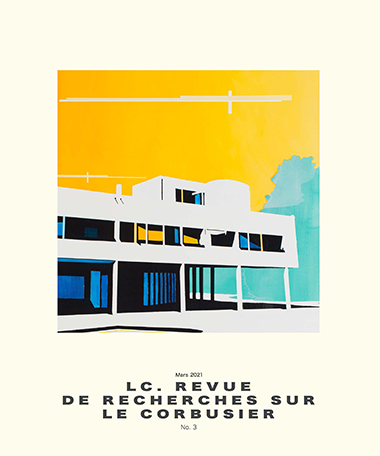
LC. No. 3 — Mars 2021
Le Corbusier, « l’avenir est à NOUS »
We are pleased to introduce the third issue of LC. Revue de recherches sur Le Corbusier, adding up to its progressive consolidation as a research journal. Once more we thank the attention of our readers, the significant number of online visits received, and the increasing presence of new articles in our pages, published in a larger number than before, always after a rigorous selection process (for which we want to express our gratitude to the excellent and generous work of our referees).
Read more
Once again, this journal aspires to echo the importance given by Le Corbusier to the plastic attributes of editorial work that he himself developed as author, designer, and typesetter of books and magazines. Hence the weight that graphic materials provided by Fondation Le Corbusier still have in our journal. The journal’s cover reflects this same meaning. For this occasion, cover design has been in charge of the Australian designer Paul Davies, whose luminous colors pose a response to these somber times.
Our guest article celebrates a double centenary. One hundred years ago, Charles-Édouard Jeanneret and Amédée Ozenfant published the first number of L’Esprit Nouveau, just before Arturo Soria’s decease. The author José Ramón Alonso aims to reveal the presence and relationship between both urbanists through the well-known project of Ciudad Lineal, thereby offering a panoramic view of the urban theories that circulated the initial decades of the previous century, all of them knew and reformulated by Le Corbusier during his life.
This comparison between Le Corbusier and a different thinker is also the topic of Javier Fernández proposal, where John Ruskin is now the co-protagonist. Two more articles approach the impact of Le Corbusier on other cultures. Ingrid Quintana and Cecilia O’Byrne dispute the critics against Chandigarh’s Capitolium Complex and recognize the dialogue it established with its place and the culture of its inhabitants. Daniela Ortiz dos Santos inquiries about the relationship between Le Corbusier and Brasil’s cultural elite, especially Paulo Prado, during the interwar period. Sarah Feriaux-Rubin defends the importance of Simone Galpin, first wife of André Wogensky whose activity at Rue de Sèvres’ atelier was quite significant. Finally, the contribution by Paula V. Álvarez uses the Appartement Beistegui to rethink the reinvention of Le Corbusier’s design techniques.
Le Corbusier’s contemporaneity is vindicated by Emilio Tuñón in the section Contemporary Le Corbusierthrough a series of reflections inspired by two drawings, one dedicated to Édouard Trouin and the other to Chandigarh, both highlighting the validity of his teachings on the act of architectural design.
The journal’s commitment to publish little-known graphic and written material by Le Corbusier is now fulfilled through the dossier “La Pierre, amie de l’homme,” which gathers unpublished documents from Fondation Le Corbusier. Photographies, drawings, and texts have been analyzed by Jorge Torres to offer new keys for their comprehension. This section’s edition in three languages answers to our journal’s compromise with divulgation, research, and internationalization.
Two book reviews, one on Le Corbusier’s correspondence with Klipstein and another on his disciples in South America, accompany the clôture. This time it verses about the receipt acknowledgment of the book CIAM 59 IN OTTERLO, accompanied by a drawing full of meaning: after thirty years of work since the CIAM creation, new generations, standing on the shoulders of giants, must assume their place and raise the flag of truth. More than fifty years after its demise, this invitation is still valid, “the future is ours,” we are still under the shelter of his thinking that still nurtures the architecture of the future and the present.
Juan Calatrava / Arnaud Dercelles / Jorge Torres Cueco
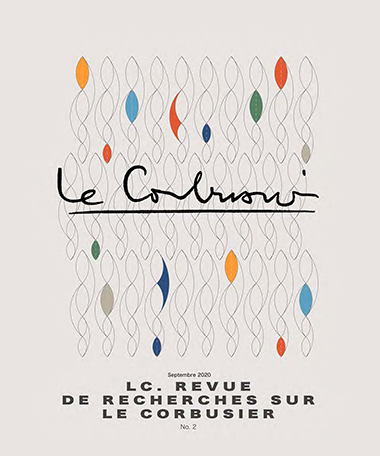
LC. No. 2 — Septembre 2020
We would like to use the first LC. Revue de Recherches sur Le Corbusier to say thank you for the extraordinary welcome that has been given to this project. Despite the adverse circumstances it encountered at the time of its appearance, the thousands of visits to the website, as well as the significant number of high-quality papers submitted, constitute a guarantity of continuity for this journal.
This issue, as the first one, is a faithful reflection of the multiform nature and wide diversity of the interests with which Le Corbusier’s work and thought continues to challenge us today. From the point of view of the history of architecture but also from the strict contemporaneity.
Read more
Le Corbusier n’est pas une simple référence historique convoquée çà et là pour évoquer, comparer ou critiquer l’architecture contemporaine, il continue de l’être une présence vivante et vivifiante. Pours l’en convaincre, il suffit de lire la contribution généreuse de Tadao Ando qui nous livre, à travers un entretien inédit illustré de dessins originaux, ses réflexions sur l’importance de Le Corbusier dans la formation de sa propre vision de l’architecture. Ce dialogue interroge sur la continuité de la culture et de l’art à travers les époques.
Une place particulière est également accordée à l’article du professeur Alessandro Fonti qui nous a quitté il y a quelques mois. Une introduction de Maddalena Mameli, en guise de glose, nous éclaire sur la figure et les travaux du professeur Fonti. Le texte publié ici est celui de sa conférence donnée lors du congrès « LC2015. Le Corbusier cinquante ans plus tard ». Cette contribution est consacrée à la révélation de la présence du mythe d’Ariane dans la production artistique et architecturale de Le Corbusier.
Une fois encore, les aspects biographiques s’avèrent, dans le cas de Le Corbusier et contrairement à d’autres architectes, pertinents, car ils échappent à l’anecdotique. Dans l’article invité, Tim Benton nous livre une étude des agendas personnels, prisme supplémentaire d’importance pour cerner la production corbuséenne. Avec méthodologie, l’auteur nous en dévoile le fonctionnement mais aussi l’organisation.
Dans une rubrique que nous pourrions appeler “Le Corbusier après Le Corbusier”, nous livrons les réfexions de Marta Mompó, Miguel Navarro et Federico Carro sur les échos corbuséens dans le projet pour la Foire de Valence. La couverture de ce numéro est quant à elle une création originale conçue par les architectes José Miguel Gómez-Acosta et Daniel López Martínez. Elle repose sur le développement géométrique du Modulor, rehaussé par des aplats de couleurs issus de la palette puristes de Le Corbusier, ainsi que de sa signature
Trois textes monographiques s’emparent de sujets particuliers. Fernando Zaparaín, Jorge Ramos et Pablo Llamazares, dans leur article traitant de la réception de Le Corbusier aux États-Unis entre 1925 et 1939, abordent la question de la fortune critique, qui demeure sans doute l’un des aspects les moins abordés de la recherche corbuséenne. Luis Rojo de Castro apporte quant à lui une contribution supplémentaire sur Le Corbusier et de la photographie. Enfin, dans son étude sur les tapisseries de Le Corbusier, Caroline Levitt nous livre un éclairage pertinent sur ce pan de création encore peu connu.
Conformément à notre idée de proposer dans chaque numéro de la revue une production corbuséenne peu connue, nous présentons, dans sa version originale mais aussi dans une traduction espagnole inédite, le discours Air, Son, Lumière, prononcé par Le Corbusier à Athènes en 1933 à l’occasion du IVème CIAM, dans lequel l’écho du Parthénon, celui de l’atmosphère grecque se fondent dans l’utopie technique du mur neutralisant. Parmi les nombreux écrits de Le Corbusier, c’est un texte d’importance pour lequel il n’est pas aisé de trouver une version exhaustive fable.
Après une rubrique consacrée aux recensions d’ouvrages, ce deuxième numéro se clôt par un visuel marquant afin de l’achever de belle manière ce voyage au cœur de la recherche corbuséenne que nous pensons inépuisable tant l’œuvre est immense.
Juan Calatrava / Arnaud Dercelles / Jorge Torres Cueco
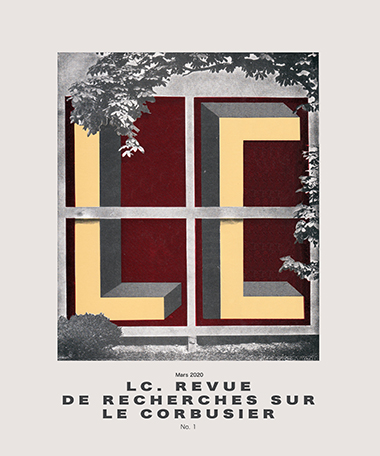
LC. No. 1 — Mars 2020
The first issue of L’Esprit Nouveau came out in October 1920. The magazine, although officially directed by Paul Dermée, was actually managed by Amedée Ozenfant and Le Corbusier. On the first page we can read its objectives “to explain the spirit that animates the contemporary era; to express the beauty of this time, the originality of its spirit […] to show the unitary spirit that encourages the different elites of our Society in their investigations. To present and to clearly comment on the works, research, ideas of those who lead our civilization nowadays”.
Read more
This declaration of intent is followed by an enumeration of the disciplinary areas that would be addressed in this new magazine:
EXPERIMENTAL AESTHETICS
PAINTING, SCULPTURE, ARCHITECTURE
LITERATURE, MUSIC
AESTHETICS IN ENGINEERING
MUSIC-HALL, FILM, THEATER, FASHION
BOOKS, FURNITURE, SPORTS
AESTHETICS OF THE MODERN LIFE
This long inventory is the reflection of the several disciplines that Le Corbusier addressed throughout his life and that can be explained by a concept: the Synthesis of the Arts, which was a vital program already formulated in 1935 under the name of “Sainte Alliance des Arts Majeurs ou Le grand art en gésine”. This Lecorbusian emblem was held on different occasions and in numerous speeches, writings, publications… “Unité”, “Appel pour une synthèse des arts majeurs”, “L’Espace indicible”, New World of Space (1947) or L ‘Atelier de la recherche patiente (1960), are all different formulations of that theoretical, almost existential commitment, of a patient search that covers all its production in the most diverse disciplines: tapestry, painting, sculpture, engraving, lithography, photography, architecture, urbanism, advertising or furniture, which are all considered under the same creative approach.
LC, in a similar way, wishes to become a new journal whose epicentre will be Le Corbusier and the plurality of his work. Initially, the book L’Atelier de la recherche patiente was to receive the title of Le Corbusier et son temps, as Le Corbusier himself wanted to be a man of his time. Like L’Esprit Nouveau, LC wants to be a “global journal dedicated to the aesthetics of our time, in all its manifestations”. This is our program: to describe generous convolutions starting from the figure of Le Corbusier in order to apprehend the aesthetics and arts of our time. We also want to recognize a heritage that will be oriented towards the future, in order to allow us to gather a wide spectrum of articles that can investigate the origins of Charles Edouard Jeanneret, his predecessors, his time, until his emergence, manifestation and decline, in the present and in the future. Trying to achieve this goal through any artistic manifestation without any limit or a priori.
The journal will publish articles including biographical, literary or textual researches, as well as analysis of architectural projects, plastic creations, designs or music, essays on genetic or inferential criticism, graphic or photography works, essays on aesthetics, etc. Our only requirement will be to promote a recherche patientein which Le Corbusier will always be a part, even in the background. Almost a hundred years ago Le Corbusier praised the “spirit of construction and synthesis, guided by a clear conception”, therefore, we will strive to give priority to rigorous, original and meaningful research.
Juan Calatrava / Arnaud Dercelles / Jorge Torres Cueco